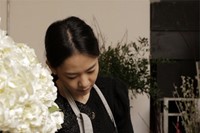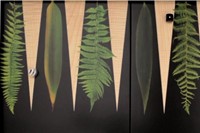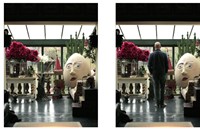AnOther presents a documentary series focusing on international craftspeople
AnOther presents a documentary series focusing on international craftspeople, in partnership with discerning Egyptian jewellery house Azza Fahmy.
Inspired and formed by its rich international heritage, Azza Fahmy was founded on the principals of craftsmanship and learning. In this film series, shot by acclaimed filmmaker Stefan Heinrichs, the jewellery house has sought out industry defining creatives who echo their ethos, uncovering their backgrounds and motivations; creating vignettes that detail the passion that makes these scions of the creative industry so unique.
As a craft, floristry dates back to ancient Egypt when cut flowers would be placed in vases to create highly stylised arrangements for religious events. Since then, flower arranging has gone through various movements: the Greeks and Romans preferred them as adornments; in ancient China they were an integral component of religious teaching and medicine. Arrangements became hugely popular during the Renaissance period, beginning in Italy and later spreading to the rest of Europe. One of the most interesting movements in the history of floristry occurred in the 1930s when evangelical florist Constance Spry modernised populist ideas about decoration in the home.
Floristry has undergone significant changes over the past few decades. Founded by Kally Ellis in 1991, London florist McQueens has established itself as one of the pioneers of a new style of British floristry, focused on beauty, elegance, simplicity and innovation.
In the first installment of the Modern Cultural Curators film series, Stefan Heinrich's short introduces Ellis at McQueens' headquarters where she candidly discusses her childhood, passions, motivations, philosophy and the importance of her team.
McQueens is a fine example of the modern, British florist. Ellis, whose heritage is Greek, has been in floristry for 22 years and has experienced lots of changes within the industry. "In the early days, it was all about that dirty word 'arrangement' – mixing flowers together with that ubiquitous green foam," Ellis explains. "Displays were really stiff and structured. We have tried to replace it with something more natural. Flowers are beautiful in their own right."
Her focus and philosophy have enabled her to continually elevate McQueens' operations: having first opened as a small shop, it now runs as a 35-strong team from the headquarters in Clerkenwell,. A mixture of nationalities and ages, they create hand-tied bouquets and displays for customers at the shop, at Claridge's hotel and at the Vanity Fair post-Academy Award party for the past 18 years. They also run a successful flower school, attracting students from all over the world.
"Flowers are so important in everybody's lives", enthuses Ellis. "They're so uplifting. For everybody's well-being, we should always have flowers around us."
For nearly 5000 years, the game of backgammon has been a source of entertainment in cultures across the world, long associated with the leaders and aristocracy of ancient civilisations including Persia, Greece, Rome, Egypt and the Far East. A derivative of the game was found in King Tutankhamen’s tomb, Plato describes a form of backgammon noting its popularity, and the Romans used it to play a classical version of strip poker. Backgammon as we now know it originated in the 1920s when an unknown New York gambler first introduced the doubling dice, requiring the development of strategy and technique, and thus creating a more intricate and popular game.
British-born Alexandra Llewellyn has established herself as one of the world's leading backgammon board designers. She was first introduced to the game when visiting her grandparents in Egypt. "We would often wander around the back streets and play a game of backgammon with the older locals. I had little in common with them – language, culture, age – but we were all able to communicate with one another through a game." Travel was an important part of Llewellyn's childhood and there was usually a backgammon board available in most of the places she visited. "Quite often it wasn't even a proper board – I distinctly recall one fashioned from bottle tops in Morocco."
Having trained in fine art, Llewellyn decided to make her first backgammon board as a thank you to some close friends. "I built the board and painted it with orchids and leaves," she recalls. "I remember the immense feeling of satisfaction making the board and then later, playing on it." In December 2010, Llewellyn decided to start her own company, specialising in backgammon board design. She now produces six key designs for her boards, adorned with unique palm, pheasant, butterfly, nude lady, antler and peacock paintings accompanied by weighted pieces and leather lined turned shakers. Each board is the result of collaborations with a number of international master craftsmen who excel in working with different techniques and materials, including Ben Gaskill, a London-based stone-mason. Gaskill and his team, working from a studio under the railway arches in Brixton, South London, create exquisite semi-precious stone playing pieces to accompany the boards.
Llewellyn also takes one-off commissions for games tables and boards, where every detail is created in close conversation with the client to create a truly original way to commemorate memories and life achievements. "I made one board for a couple which was made up of their love letters to each other over a period of 50 years. It had American black walnut with hand painted surface, engraved playing pieces and secret messages embossed in leather."
"I'm inspired by the incredible history of the game of backgammon", Llewellyn explains, "but also the board itself as a beautiful centrepiece. I love how it brings people together."
"I help to create a three-dimensional environment where something takes place, be it a fashion show or a photo shoot" is how Simon Costin would quickly summise his craft. Of course, there's a lot more to Costin and his vast body of work. Since graduating from Wimbledon, he has gone on to establish a trademark aesthetic that often conjures up the terms wonderful, magical and fantasy. Working with leading talents such as Tim Walker, Alexander McQueen and Paolo Roversi, story-telling is always at the heart of his work.
The centre of Costin's world is his east London home, a four-storey Victorian house which is crammed with many of the props that have once featured in his work, ranging from the unusual to the macabre. An oversized painted Humpty Dumpty from an iconic Tim Walker shoot, a glowing Love lightbulb sculpture commissioned by Italian Vogue, an 18th century Italian state coffin and various wax mannequins and taxidermy figures. The love of "stuff" can perhaps be traced back to his upbringing – both of his parents were antique dealers so, as a child, Costin was always surrounded stby unusual objects and artefacts.
Costin, a charming and enthusiastic character, studied theatre design at Wimbledon College of Art, where he learnt a variety of skills including mask-making and costume design, and his weekends were spent at The Natural History Museum, attending a taxidermy course. During his course, he created a series of small, unusual pieces of body sculpture made from fish heads, and versions of the designs eventually ended up at the V&A and New York's MET. "I became tired of the scale of jewellery – I always wanted to be making bigger things," Costin explains. Through a series of introductions by friends, Costin began working on pop videos for indie bands including Suede and Pulp – "It was a great learning curve because the budgets were tiny. I'd have to whip something together with a glue gun, some fabric and a stapler." Later moving into the sphere of fashion, Costin has become an internationally respected art director and set designer – no doubt chosen for his talents as much as his infectious personality and passion for each project he undertakes. He collaborated extensively with the late Alexander McQueen on his own line and for his shows at Givenchy as well as designers such as Gareth Pugh.
When not working on set or sourcing props or materials, much of Costin's time is spent at home, which incorporates a studio and an extensive library. "The house is good for feeding my creativity", he says. "It's a very social house – I like cooking and having people over." The house is also the place where Costin spends time working on his other passion – research for The Museum of British Folklore, which he both founded and is the director. It is Britain's first organisation solely devoted to the celebration of our continuing living folk culture. "I’ve always had a love of museums and objects and the relationship between objects and the stories they tell and that sort of thing", he says, "and folklore is something that I think the British have overlooked for such a long time."
To discover more about The Museum of British Folklore or to make a donation, click here
There are many strands to Bokja, a Beirut-based company that has flourished since its launch in 2000. At the heart of the company are founders Hoda Barodi and Maria Hibri. "I think we were meant to be together, to join those forces that we are. We never thought it would last that long – it's been 13 years now," explains Hibri who hails from southern Lebanon and has a background in business economics.
Surprisingly, neither of the pair have previous design experience, but each have strong tastes and sensibilities and share a love for antiques and vintage furniture, as well as a passion for ancient textiles and tapestries from the Levant and countries along the Silk Road. Barodi, who has always lived in Beirut, originally trained in Arabic literature. "I forget who introduced us initially," Barido explains. "For me all that I remember that it was a meeting of passion and a meeting of the minds. "
The name is an Arabic word meaning "the wrap where you put the dowry of the bride," Hibri explains. "When a woman is born, the women in her family start embroidering her dowry, and when she gets married and leaves home to go to her new life she puts all those hand-embroidered things made with love in that bokja." The Bokja range, whose clientele includes Christian Louboutin and Julia Roberts, extends from bespoke furniture to cushions, stuffed fabric animals and T-shirts, each promoting a poetic use of colour, modern femininity, an emphasis of craftsmanship and the sustainable use of available materials. A typically original piece is the Chair With a View - a small chair with shutters and a picture of the Pope.
The atelier houses talented artisans who specialise in embroidery, knitting and assemblage as well as fabrics from across the world and antique furniture. And in the same neighbourhood, there is a breathtaking, derelict palace, currently occupied by local carpenters, which serves as a second atelier for Bokja. The company's shop, located in the Saifi district in downtown Beirut, occupies the ground floor of a 1950s structure off a street historically known for its carpenters' workshops.
Locations are key to Bokja, from the city of Beirut to the various international locales where the company operates from. "Beirut in it's own right is an inspiration. It's a city that is layered and every layer is an inspiration to us. You have the beauty; the ugly; the chic; the rainbow; the concrete jungle. So many juxtapositions," Barodi explains. "Our work is all about juxtapositions; it is a mirror of the city we live in. We juxtapose beautiful and ugly."
The world of perfume and the small pool of talented perfumers who work within the industry is a fascinating realm to explore. Whilst most of us are familiar with the iconic fragrance bottles and their accompanying campaigns, less is known about the perfumer, or the 'nose' behind them. These individuals are specialists, effectively artists who are highly trained in the concepts of fragrance aesthetics and capable of conveying abstract concepts and moods with delicate fragrance compositions.
Geza Schoen is a leading independent nose, and the man behind one of the world's most standout fragrances, Escentric Molecules. Having previously resided in London, New York and Paris, German-born Schoen now lives and works from his home in Berlin, on the top floor of a 1960s apartment block in Kreuzberg. The apartment includes a small laboratory, which contains the all-important tools of his trade: raw materials, a scale and mixing accruements. He has recently realised that a fun way of crossing his modernist apartment, from laboratory to desk, is using a skateboard.
Schoen's father was an art teacher, and as a result he "was exposed to lots of weird things at an early age" and creativity was fully encouraged. Unusually, the young Schoen became fascinated by perfume samples and began to collect them, quickly teaching himself to identify the smells of each one blind. His formal training at the German company Haarman and Reimer took five years, in a class of just four students. "In those days, it was rare to want to train as a perfumer. You were fully aware that it wasn't Karl Lagerfeld actually creating his fragrances but the role of the nose wasn't so clear."
Escentric Molecules, a sophisticated, elegant and unique perfume proposition, first launched in 2005, but the initial idea came 15 years before. The fragrance now has three series and a dedicated following, spearheaded by word-of-mouth recommendations (or more accurately, sense of smell, and regular 'What is that perfume?' enquiries) rather than a global ad campaign. The idea was born out the minimal mood of the 1990s: "So many of my friends didn't want to be wearing fragrance after the heady scents of the 80s. I realised that it was time to introduce something that was cleaner." The genius and success of the fragrance lies perhaps in its stark simplicity. There are two bottles, 'Molecule' and 'Escentric'. Molecule contains Iso E Super, a chemical Schoen was first introduced to during his initial training which has never been used on its own in the history of fragrance, and 'Escentric' which combines 65% of Iso E Super with 35% of perfume components.
Another unique offering from Schoen came in 2008, through a collaboration with British design duo Boudicca. Presented in an aluminium spray can (which Schoen now admits is a key flaw in the commercial potential of the fragrance) the two-part series includes a blue spray which fades when applied to the wearer. Inspired by the war paint worn by Boudicca, Queen of the Iceni tribe, the fragrance employs herbal notes of juniper berry, cardamon, nutmeg, clary sage, coriander seed, angelica root, hints of black hemlock extract, saffron, treemoss and tuberose, among others.Asked about the appeal of his work, Schoen explains: "I think smell is the most powerful sense we have, and the most fascinating. It is also quite mystical – you can't see what I do, which gives perfumery a sense of magic."
"I'm in the business of good times," says Lilly Vanilli, who has quickly become one of London's most celebrated cake makers. She's right – cakes are for joyous occasions, weddings, birthdays, anniversaries and happy gatherings. Self-taught Vanilli has carved a distinct niche for herself in the world of baking, using seasonal produce and toppings (glitter, edible flowers and berries) and never making the same cake twice.
"We use a local greengrocer on Broadway Market," Vanilli explains. "and a butchers and grower in Cornwall – Sean O'Neil of The Modern Salad Grower grows organic edible flowers at Keveral Farm and is fantastic. Our millers are a generation miller based in Essex."
Vanilli had an international upbringing: raised in Saudi Arabia, she later moved to New York and then Melbourne. "Cooking was never really a big part of my childhood," she explains, "we were freezer food kids." But her grandma did have a love of baking and would often involve her in kitchen activities. Vanilli's obsessive nature drew her to the science and history of baking and designing cakes. She continues to collect vintage books, many of which line the shelves of her east London bakery.
A few years after starting to make cupcakes for friends, Vanilli's burgeoning business now includes a sweet and savoury bakery, open to the public every Sunday and an in-demand private order service. In addition, she has produced two cook books and co-founded the Young British Foodies, an awards dedicated to celebrate new talent. Alongside her trademark tiered cakes, Vanilli's rich back catalogue ranges from the decadently beautiful to the macabre: floral tiered pastel cakes, Bleeding Hearts cakes and zombie cupcakes.
As well as a unique portfolio, Vanilli's success can also be accredited to her distinct style of visual communication. A modern, all-important move in these digital times – her predecessors in cake land, Mrs Beeton and Mary Berry, certainly never had to worry about such things. As a former graphic designer and journalist, Vanilli has co-created GIFs and short films featuring her cakes and uses Instagram to document each creation. Every cake is photographed in front of the same bakery wall, for that all-important continuity. "Instagram works like a visual reference for me. I haven't found a better way of communicating what I do. It's completely transformed my business."
"I really enjoy the decorating part of cake-making," Vanilli explains. "But, really, it's all about the eating part! The cake always has to taste as good as it looks."
Vanilli is currently working in India where she is planning to open a bakery in Kerala 'Bloomsbury's' in Kochi. "It's western style patisserie with Kerala ingredients and flavours," she explains, whose bakery is still opening every Sunday in the safe hands of her team.
Films by Stefan Heinrichs





